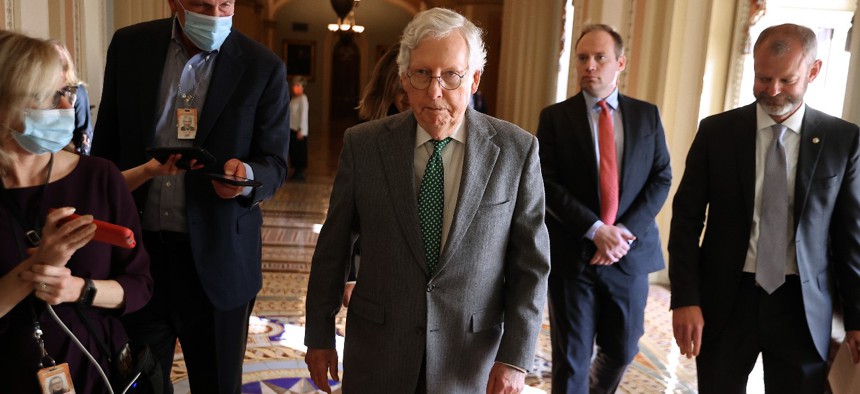
Senate Minority Leader Mitch McConnell walks with staff to the office of Senate Majority Leader Chuck Schumer on Capitol Hill. Chip Somodevilla/Getty Images
Congressional Leaders Reach Deal as They Look to Avoid Debt Default, Furloughs
Lawmakers concoct complicated schedule to raise borrowing limit that will require at least some Republican support.
Leaders in Congress have tentatively negotiated a deal to set up a vote to avoid a breach of the debt ceiling, which would have catastrophic consequences for the economy and for federal agencies and their employees.
Republicans have been dead set in forcing Democrats to pass a measure to raise or suspend the debt limit on their own, while Democrats have pushed for a bipartisan compromise. Senate Majority Leader Chuck Schumer, D-N.Y., and Senate Minority Leader Mitch McConnell, R-Ky., on Tuesday put forward a compromise to allow Democrats to quickly increase the debt ceiling without Republican interference.
Congress will first pass a bill that limits debate and amendments for a future measure to raise the debt limit, teeing up a simple majority vote for the latter measure. Since Democrats control 50 seats in the Senate, every Republican can vote against it and the bill can still become law. The initial measure to set up that vote, however, will require at least 10 Republican supporters. McConnell and Schumer had originally floated attaching that procedural plan to the annual defense authorization bill, but will instead embed it with a measure to put off cuts to Medicare that were otherwise scheduled to take place. It gives the Senate through Jan. 15 to pass a debt ceiling increase with the special conditions in place.
The Treasury Department is set to reach its borrowing limit as soon as Dec. 15. Treasury Secretary Janet Yellen recently warned lawmakers. The Bipartisan Policy Center closely tracks government spending and its impact on the debt limit, and said the default date could range from Dec. 21 to Jan. 28.
There is no blueprint for how the government would operate if it breaches its debt ceiling, though it is clear agencies would not be able to carry out their normal operations. Because typical spending outpaces the revenue the Treasury Department brings in on a given day, the federal government would only be able to pay 60% of its bills in a given month of a default scenario, according to a Bipartisan Policy Center estimate.
Analysts and Treasury officials have sketched out two possible outcomes during a default: the government would either delay payments until it collected enough revenue to cover them, or prioritize some payments while allowing others to go unpaid. In either scenario, agency payments to beneficiaries, states, grantees, contractors and, potentially, their own employees, could be disrupted. Some federal workers could be furloughed or asked to continue working on the promise of back pay in the future.
If Congress manages to pass the measure, it would mark the second crisis averted this month for federal agencies. Biden last week signed into law a 10-week stopgap funding bill, giving Congress until Feb. 18 to come up with full-year appropriations and avoid a shutdown. Lawmakers flirted with a default earlier this year, but ultimately agreed to a short-term ceiling raise in October.







